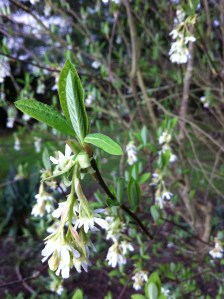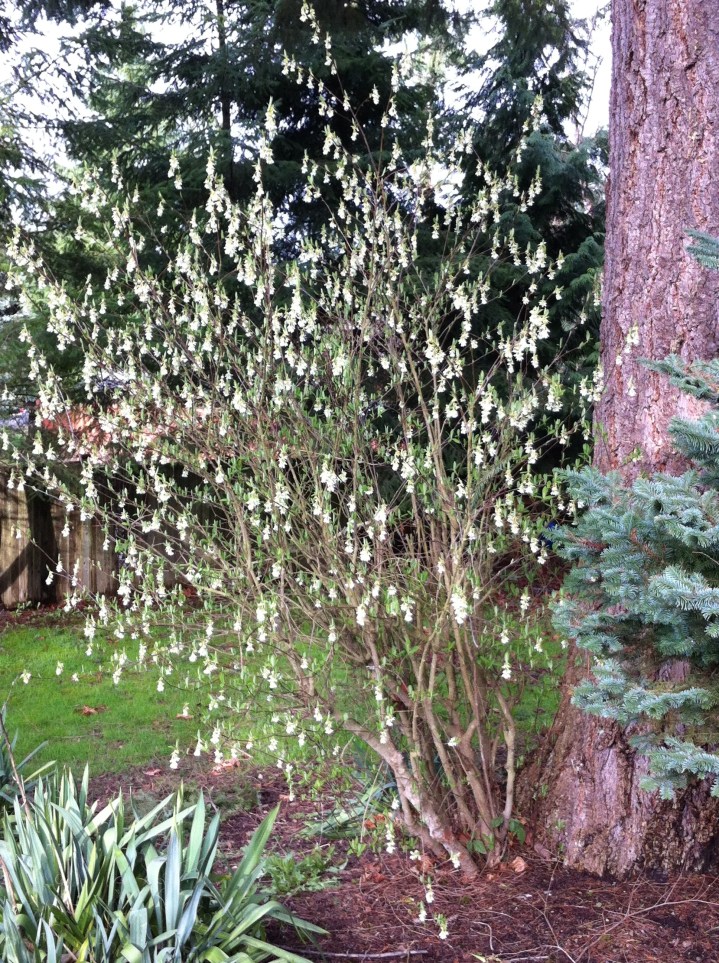
This delicate native shrub is hard to miss right now in mid-March. It’s a funny little chameleon. Most of the year it’s standard green, blending in and camouflaging with other Northwest native plants. But suddenly in March the small, trembling white flowers seem to be suspended on all the branches. Soft and white they peek out of the brown, bare woods, the bright green leaves just emerging on Indian Plum, or Oso Berry. When I first heard of this plant it was mid-summer and I was excited to find a native ‘plum’. Something we could eat and harvest! I had visions of picking the juicy fruit, and feasting, rather like we do on the sweet wild blackberry. I grabbed my girls and a bucket for collecting and off we trekked, in search of this new wild harvest. We had a greenbelt in our neighborhood and located a few Oemleria cerasiformis within a mile of our house. We were so excited to pick the ‘plums’, to try a tasty new fruit and maybe even make jam! To our surprise, the fruit was rather small, more like a large olive, than a plum. To our further surprise…. yuck! They did not taste good. These plums were sour and hardly palatable. We quickly changed our attitude from eager to try the first bite, to daring each other just to take a bite. It went into the pool of survival food. Something to remember when we were really, really, hungry and stranded in the woods. Maybe we could make jam, but only with lots of sugar and a few cups of berries as well.
And so this plant was summarily dismissed and not often considered, until now, in the middle of March. It’s early spring and the flowers seem to float upon the branches. But wait, there is another unpleasant surprise concerning Indian Plum. In Plants of the Pacific Northwest Coast by Pojar and MacKinnon the ‘unusual fragrance’ of the flower is described as something between watermelon rind and cat urine. I am here to tell you that I did not detect one whiff of watermelon, but have just inhaled deeply the scent of stinky kitty pee. Pee-u! I keep going back for a re-sniff and keep getting the same sour scent. My cat finds it quite interesting. My family won’t get involved. I wonder what type of pollinator is attracted to this? It’s a strong fragrance, pungent and pure, pp. So enjoy this lovely native from a distance, once you know what to look for in March, they seem to be everywhere in the native landscape. Another plant surprise!
Just the Facts
Oemleria cerasiformis, Indian Plum or Oso Berry
Height 4-15 feet
Shade-loving, dry to moist, open areas, stream banks, roadsides.
Flowers: Male and female flowers on separate plants, greenish-white, appear early in year, before leaves, ‘unusual’ fragrance! (see above)
Leaves: Alternate, deciduous, lance-shaped, 5-12 cm long, not toothed, strong cucumber like smell when crushed (more smells!)
Fruits: Peach colored, ripening to bluish-black, edible but bitter.
For more great Northwest Native Plant information, read Pojar, or check out The Wild Garden, a web site devoted to Natives!


This shrub reminds me very much of flowering currant (Ribes sanguineum) which has similar looking, but red, flowers. I was tempted to bring some into the house once… never again! It also smells awful! I’ve never tried eating the berries as they are so small. Thanks for a really interesting post again!
I think these types of plants use the smell to help in survival perhaps…not sure…. but the birds will devore those plums like crabapples (also to sour to eat)…natives are for the critters mostly so as long as they are fed its a good thing…I bet in winter you will find may birds hanging in those trees…not sure about the pollinators…that would be interesting to find out.
I don’t think I’ll suggest underplanting your Indian Plum with Skunk Cabbage and Stink Currant. It really seems like so many of the Pacific NW natives have one very desirable quality and one (at least!) EXTREMELY undesirable quality, doesn’t it?
I trained my brain to consider it a vegetable, and it changed everything. I told my kids they were “salad berries” so they wouldn’t expect “plum” flavor. They dip them in raspberry vinaigrette and put them in salads, as well.
What a great idea!
I wonder if you ate it too soon?